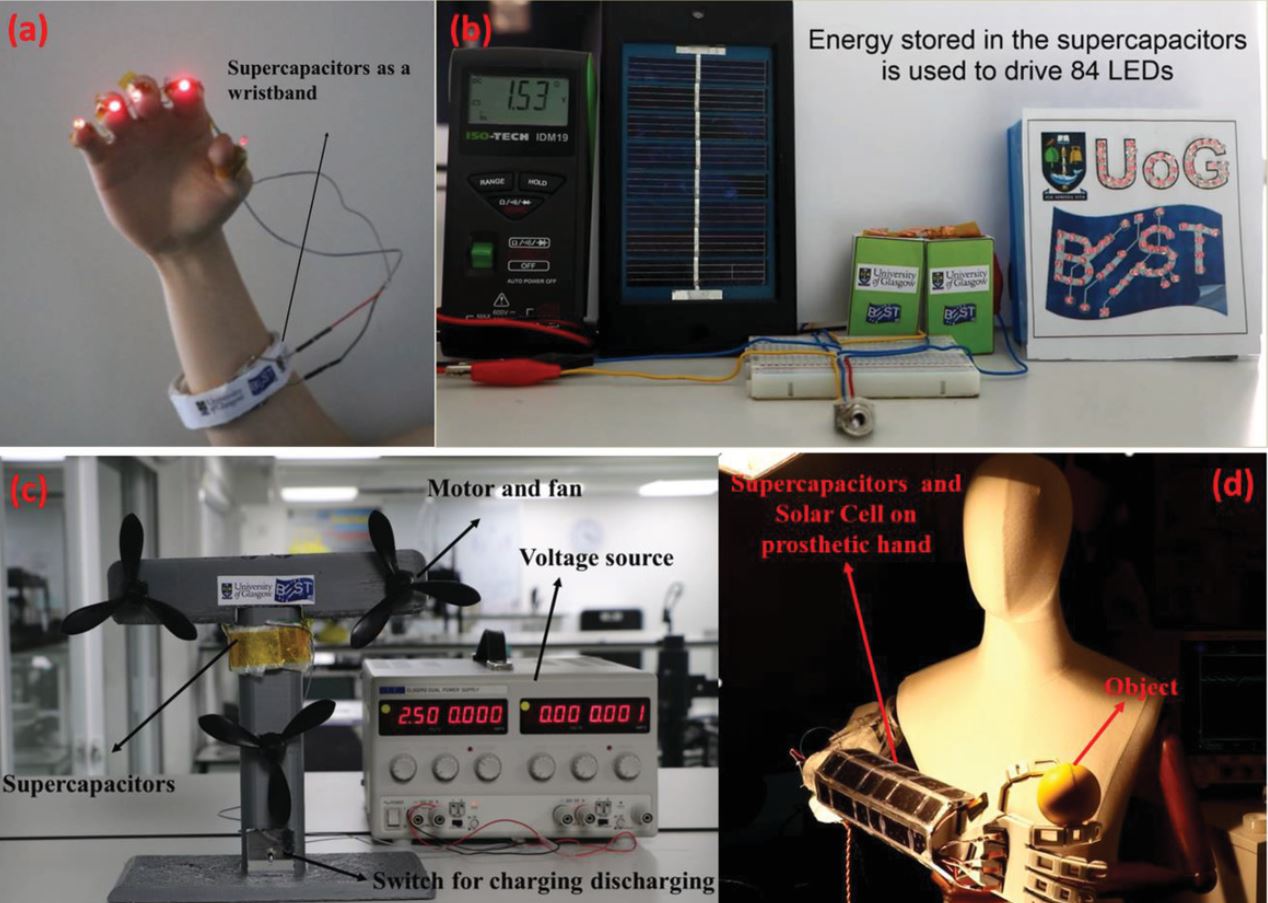
Solar-powered prosthetics for amputees are becoming a real possibility thanks to a breakthrough in energy storage technology. The new technology could pave the way for a new generation of flexible electronics, say researchers from the University of Glasgow
They wrote about their work in the prestigious journal Advanced Science (citation below). The authors were Libu Manjakkal, William Taube Navaraj, Carlos García Núñez, and Ravinder Dahiya.
The authors wrote about how they used layers of polyurethane and graphene to create supercapacitors. The supercapacitors can generate solar energy and store the excess energy so that it can use it later.
To show how effective their new solar-powered material is, the researchers powered a series of devices. They powered a string of eighty-four power-hungry LEDs and high torque motors in a prosthetic hand. The hand was able to grasp several different objects.
Solar-powered wearables and e-skin
Professor Ravinder Dahiya leads the University of Glasgow’s Bendable Electronics and Sensing Technologies (BEST) research group. Among the group’s achievements are the development of energy-autonomous wearables and e-skin.
Dahiya is a Professor of Electronics and Nanoengineering at the University of Glasgow’s School of Engineering.
The top touch-sensitive layer is made from graphene, a ‘super-material’ consisting of carbon layers just one atom thick. Graphene is the world’s lightest, strongest, and thinnest material. It is also surprisingly flexible.
How the solar-powered material generates energy
Sunlight passes through the top layer of graphene. Below, there is a layer of flexible photovoltaic cells. When the sunlight hits the photovoltaic cells, they generate electricity, i.e., solar power.
A newly-developed supercapacitor stores any surplus power. The researchers used a graphite-polyurethane composite to make the supercapacitor.
According to a University of Glasgow press release:
“The team worked to develop a ratio of graphite to polyurethane which provides a relatively large, electroactive surface area where power-generating chemical reactions can take place, creating an energy-dense flexible supercapacitor which can be charged and discharged very quickly.”
Previously-developed supercapacitors could only deliver voltages of up to one volt. They were, therefore, not suitable for powering most electronic devices. That is, until now.
The new supercapacitor can deliver 2.5 volts. That is enough power for many applications today.
The researchers tested their new supercapacitor in the lab. They powered it, discharged it, and then powered it again 15,000 times. They detected no significant loss in its ability to store the energy it generated.
Solar-powered graphene-based devices
Study leader, Prof. Dahiya, said:
“This is the latest development in a string of successes we’ve had in creating flexible, graphene-based devices which are capable of powering themselves from sunlight. Our previous generation of flexible e-skin needed around 20 nanowatts per square centimetre for its operation, which is so low that we were getting surplus energy even with the lowest-quality photovoltaic cells on the market.”
“We were keen to see what we could do to capture that extra energy and store it for use at a later time, but we weren’t satisfied with current types of energy storages devices such as batteries to do the job, as they are often heavy, non-flexible, prone to getting hot, and slow to charge.”
“Our new flexible supercapacitor, which is made from inexpensive materials, takes us some distance towards our ultimate goal of creating entirely self-sufficient flexible, solar-powered devices which can store the power they generate. There’s huge potential for devices such as prosthetics, wearable health monitors, and electric vehicles which incorporate this technology, and we’re keen to continue refining and improving the breakthroughs we’ve made already in this field.”
The Engineering and Physical Sciences Research Council (EPSRC) funded the study.
Citation
“Graphene–Graphite Polyurethane Composite Based High‐Energy Density Flexible Supercapacitors,”
Libu Manjakkal, William Taube Navaraj, Carlos García Núñez, and Ravinder Dahiya. Advanced Science. First published: 13 February 2019. DOI: https://doi.org/10.1002/advs.201802251.
